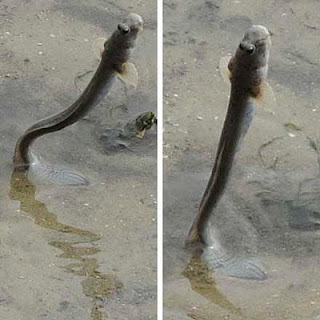Thursday, 27 October 2011

mangrove swamps are found along tropical coasts near the equator.
the strange-looking trees, fish that can walk & crabs that wave to each other!
mangrove trees look as if they are growing on stilts as their roots,
supporting them in the mud, come out of the water. the tangle of
roots is a greater hiding place for young fish
young fish?
mudskipper has gills but it mostly breathes via its skin.
this allow the fish to leave the water
it uses its stiff front fins to push its body across the mud
& even up mangrove roots
ospreys are the top hunters in a mangrove swamps.
they feed on fish & small animals. build their nests,
out of twigs which they use for numerous years
the male fiddler crab has an extra-large claw that he waves up
& down as signal to other crabs. at low tide, the male fiddler crab
sits at the entrance to his burrow & waves his claw to attract females!
mangrove swamps help to protect coasts from hurricane
& tsunami damage. they act as barriers between the sea & the land
croxfiber's sweet memory at sungai bangau-mangrove zone
i.e. 9 mangrove jacks & one grouper
credits: my first ocean life encyclopedia/ flickr/ numerous data
Posted by abg.CF at 08:11 0 comments
Labels: fiddler crab, grouper, info mangrove, kerapu, mangrove jack, mudskipper, ospreys
Thursday, 20 October 2011
membangan
muara zone
prawn & mantis shrimp / stomatopods (santak/ udang lipan/mentadak/ ronggeng)
snapper species..
Posted by abg.CF at 08:11 0 comments
Thursday, 13 October 2011

anhinga bird spotted the fish swimming in a river
the hunt is on target!
ouch! this fish meets a spikey end when a bird spears it using its beak
focus...
the crafty anhinga can swim like a U-boat with its body submerged below the waterline and only its neck protruding like a periscope to creep up on its unsuspecting prey before spearing its target with a sudden thrust
oooo dear.. i'll be dead soon
glup...
the predator shook its meal free before throwing it into the air and catching it in her mouth, swallowing it down in one
the anhinga sometimes known as snakebird, american darter, water turkey, devil bird or darter
credits: dailymail.co.uk/ alfred forns/ wikipedia/ flickr/ various data
Posted by abg.CF at 08:11 0 comments
Labels: Anhinga
Thursday, 6 October 2011

estuaries & deltas form where rivers flow into the ocean. believe it or not.. here, the fresh water of the river mixes with the salt water of the ocean
the nile delta lies at the mouth of the river nile in egypt. over thousands of years, the river has dropped large amounts of mud. this mud has bulit up into low-lying land with lots of channels of water leading out to sea
as a river gets close to the sea, it gets wider & wider, hence starts to weave about in a large bends called meanders (river bends)
the wide mouth of a river, where it neets the sea is known as estuary
some sea otters live in the shallow water of estuaries. they hunt for carbs, mussels & snails on the sea bed. they fancy to eat while floating on the surface of the water
the mud at a river mouth is full of worms & snails, which attract flocks of feeding birds
birds use their long beaks to find food in the mud
sea otters have the thickest fur of all animals. the fur insulates their bodies, keeping them warm while they swim in the cold water
tidor ya banggg... the sleeping beauty hahahaaaa
credits: my first ocean life encyclopedia/ flickr/ various info
Posted by abg.CF at 08:11 0 comments
Labels: info estuaries, ottter















